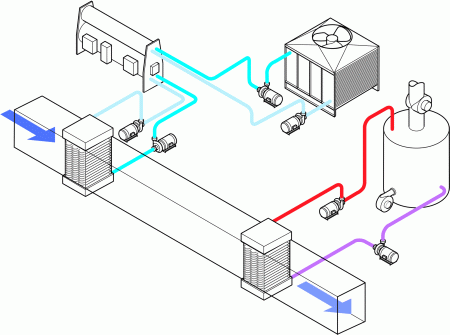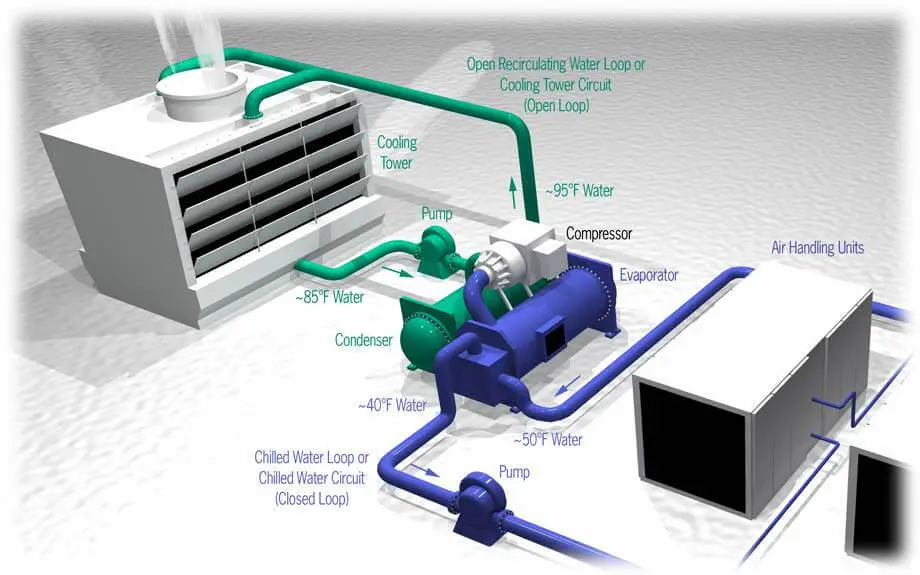What is an HVAC ?
Acronym HVAC stands for heating, ventilation and air conditioning. Sometimes Refrigeration “R ” is also added and it becomes “HVACR”.
HVAC is basically climate control of confined space with respect to requirements of persons or goods in it.
HVAC system is not only heating and cooling of air but also concerned with maintaining the indoor air quality (IAQ).
Heating of air is done usually in winter and similarly cooling of air is done in summer season.

HVAC system works on the principles of thermodynamics, fluid mechanics and heat transfer.
All these fields come into play in various components of HVAC. IAQ Indoor air quality is the quality of air inside the building or structures as mostly related to health and safe keeping of its occupants or items/goods placed. IAQ is changed with inclusion or contamination with gases and uncontrolled mass & energy transfer.
HVAC systems are used for heating and cooling & air condition in homes, building, industry, vehicles, aquariums and many more.With the passage of time application of HVAC are increasing and more research is in-progress in this field.
HVAC business is also increasing at the same pace as field of application is broadening.
What is a HVAC System?
HVAC system is basically an assembly of various types of equipment installed together to provide heating and cooling along with indoor climate control. HVAC systems involve mechanical, electrical and I & C components to provide comfort to the occupants of building/space or to preserve goods, products or items placed in space.
HVAC cooling systems may be integrated with HVAC heating systems or these may be installed separately depending upon HVAC design. HVAC system also serves on industrial scale to keep the machinery running by maintaining the temperature of space/hall/room where machines are installed. HVAC water chillers have become essential for any industry for its various needs.

HVAC System Basic Components
An HVAC System may include the following basic components or units.
- HVAC water chillers and heaters
- Hot water generator (if chiller does produce chilled water only) or furnace
- Chilled water pumps
- Cooling water pumps
- Electrical power supply control or Motor control center (MCC)
- Cooling towers
- Piping for chilled water and cooling water or condenser side water
- Valves for chilled water and cooling water sides
- Air handling units (AHUs), heating coils and cooling Coils
- Ducts in ventilation system (supply ducts and return ducts)
- Fan Coil Units (FCUs) and thermostats
- HVAC Diffusers and grills
- HVAC controls (instrumentation & Control components) installed at various locations
- HVAC software for building HVAC control or building management system (BMS)
- An Assembly of all above components forms an HVAC system.
HVAC system working Principle
In the background of HVAC system, an HVAC water chiller produces chilled water which is then circulated throughout the building or space upto cooling coils in air handling units. Blowers move air on cooling coils which is then distributed into various portions of space or building for providing comfort or preserving goods/items as per HVAC design.
Air is distributed through supply ducts and return air is collected in air handling units with the help of return ducts.Chilled water and cooling water pumps provide energy to keep the chilled and cooling water moving.
HVAC Valves are also installed at various points in piping to ease the maintenance of HVAC system or for the sake of system control. Heating of air may be done with the help of HVAC heat pump, hot water generator or simply by furnace. Some industrial chillers also serve as heaters in winter season. Heating coils take the place of cooling coils in case of heating mode.
HVAC system cost may vary for different applications as heating and cooling space or environment varies. Looking for cheap HVAC systems may involve little research in types of HVAC systems and HVAC suppliers otherwise you would be lamenting over waste of millions of dollars for selecting wrong HVAC designer & contractor.






